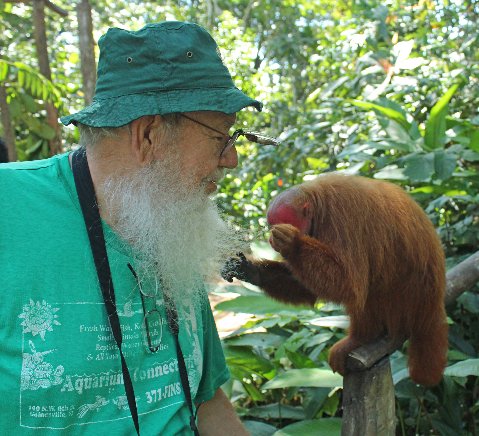I sat in the yard this morning watching the ducks swim in their little pool and the dogs play rambunctiously over the expanse of the yard. It was a sunny 75 degrees Fahrenheit and very comfortable overall. Then came the blue jays. Within moments there were 8 or 10 of them, all screaming at the top of their lungs.

Then came an American crow, and then another. Cawing and gurgling they joined the screaming jays. At first I thought this to be an owl response, but even with binoculars I could see neither an owl nor a hawk. But then I noticed the birds seemed to be looking down and finally, in a leafy limb-end bower, I made out a sinuosity of form - a snake. It was small, probably only 3 feet long or perhaps even a bit smaller.
As I watched, it began moving downward and it was apparent that it was a yellow rat. The snake's movement prompted the jays to find a new upper level of volume to their cacophonous calls. The snake didn't seem to care. I stood and moved towards the tree and the crows, more nervous than the jays, departed.
The snake continued downward until less than 20 feet separated us. The jays, with a final look of disdain, flew away. The rat snake got to the lowest limb, moved in towards the trunk and the last I saw it was coiling slowly, largely secluded between the trunk and an immense grape vine that clambered up the tree.
I walked away thinking this was a lucky snake. Perhaps it was because I was so close that the frenzied calls of the jays and crows hadn't summoned a red-shouldered hawk. Had one of these herp-eating buteos arrived the ending for this tale and the snake would probably have been just that: a literal ending.
Snake in a tree: a yellow rat snake at home.

Olive yellow ground color and heavy striping is typical of yellow rat snakes in my region.

 Author, photographer, and columnist Richard Bartlett is one of the most prolific writers on herpetological subjects in the 20th century. With hundreds of books and articles to their credit, Richard and his wife Pat have spent over four decades documenting reptiles both in the field and in captivity. For a list of their current titles, please visit their page in our bookstore. Author, photographer, and columnist Richard Bartlett is one of the most prolific writers on herpetological subjects in the 20th century. With hundreds of books and articles to their credit, Richard and his wife Pat have spent over four decades documenting reptiles both in the field and in captivity. For a list of their current titles, please visit their page in our bookstore. |




To prevent automated Bots from commentspamming, please enter the string you see in the image below in the appropriate input box. Your comment will only be submitted if the strings match. Please ensure that your browser supports and accepts cookies, or your comment cannot be verified correctly.